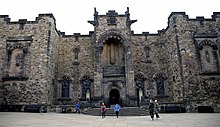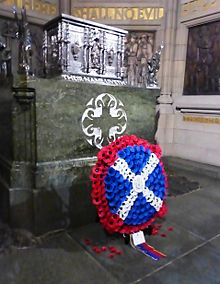Scottish National War Memorial


The Scottish National War Memorial is located in
The Rolls of Honour kept in the memorial include the names of those Scots servicemen and women and Scots civilians that died in all wars after 1914.
The memorial rolls list close to 135,000 casualties of the First World War and over 50,000 of the Second World War.[1] More casualties from later wars are also inscribed, including from the Malayan Emergency, the Korean War (1950–1953), Operation Banner (1969–2007) during The Troubles, the Falklands War (1982), and the Gulf War (1990–1991).[1] Most recently casualties from Iraq and Afghanistan have been added to the Rolls of Honour.

Development
Proposals for a Scottish National War Memorial were put forward in 1917, during the
The Memorial
The exterior of the building is decorated with
Gallery
-
Plan
-
'Courage' by Alexander Carrick
-
The apse
-
Heraldic unicorn with a St Andrew's cross flag and a thistle finial
-
Memorial to the Royal Air Force in a laurel wreath by Pilkington Jackson
-
The western façade with 'Freedom' by Percy Portsmouth and niche capitals Phyllis Bone
-
Scottish National War Memorial from the north, showing the shrine. The niche statue is 'Truth' by Alice Meredith-Williams and niche capitals by Phyllis Bone.
-
Unicorn from theroyal arms, with a shield bearing a St Andrew's crossby Phyllis Bone
-
Gargoyle and the lion with theroyal arms
-
Rib vaulting
-
The apse interior
-
Military badge of theroyal arms
-
Hall with naval ensigns and military colours
References
- ^ a b c d e "History". Scottish National War Memorial. Retrieved 21 December 2020.
- ^ a b c d "FAQ". Scottish National War Memorial. Retrieved 21 December 2020.
- ^ Hussey, 1931; Dictionary of National Biography, 1937
- ^ a b c Henderson, Diana M. "History of the Scottish National War Memorial". Scottish National War Memorial. Archived from the original on 18 July 2011. Retrieved 19 March 2011.
- ^ "John Marshall (1888–1952)". Glasgow Sculpture. Retrieved 22 June 2018.
- ^ "Phyllis Bone's Sculptures". The Natural History Collections. The University of Edinburgh. Retrieved 16 November 2017.
- ^ McWilliam et al, pp. 99–100
- ^ "Scottish National War Memorial". UK National Inventory of War Memorials. Archived from the original on 5 July 2008. Retrieved 3 May 2011.
- ^ "Scottish National War Memorial, SC009869". Scottish Charity Register. Office of the Scottish Charity Regulator. Retrieved 25 July 2011.
Sources
- ISBN 9780140710687.
External links
 Media related to Scottish National War Memorial at Wikimedia Commons
Media related to Scottish National War Memorial at Wikimedia Commons- Scottish National War Memorial website















